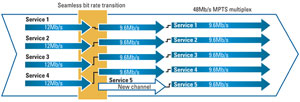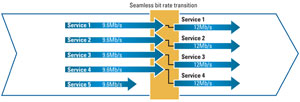Seamless Channel Insertion
Television broadcasting changes quickly and is being shaped by new usages and services. Program offerings and live events access continue to grow significantly. Every day, news and sports contribution feed providers face the challenge of juggling the number of programs they must deliver and available bandwidth. As the number of programs is not constant, broadcasters and service providers need to continually optimize the use of their bandwidth on their transport multiplexes. Today, this process is primarily done by a manual intervention with limited scalability.
The MPEG standards offer an alternative way of managing bandwidth constraints dynamically named Piecewise CBR, which can be used to address this challenge and make the operational workflow as efficient as possible. This new mode allows a dynamic and seamless change of the video elementary stream bit rate. Operators in a truck or in a facility can use it to adapt and optimize the bandwidth allocated to each signal with no interruption of service. Seamless Channel Insertion (SCI) provides flexibility and opens automation possibilities in complex contribution networks.
SIDEBAR: Definition
Seamless Channel Insertion (SCI) is based on the open/nonproprietary standard called Piecewise CBR. Piecewise CBR extends the conventional constant-bit-rate mode (CBR) for digital video compression by allowing the change of the program bit rate on demand and without any disruption at the receiving end. Between each bit-rate change, the program is encoded at a constant bit rate. Because it relies on features offered by the MPEG open standards at both transport stream and elementary stream levels, Piecewise CBR feeds can be decoded without change using existing MPEG receiver devices.
Multifeed contribution context
Sports television program providers know well that the duration of a soccer game is not always 90 minutes, and the game may go into overtime. Tennis finals can be delayed because of rain, and a golf tournament could last longer than expected. In this situation, a new channel may need to be added in the multiplex while other programs are unexpectedly overlapping the scheduled transmission slot. Hence, the sports feed distributor could face a peak of usage in its multiplexes because the line-up of feeds to deliver becomes too important at the time. Live feed turn-around operations are often subject to immediate changes, but it is unlikely that world feed distributors will get in touch with satellite or fiber service providers to instantly adapt the bandwidth capacity. Therefore, an extra bandwidth capacity margin will be rented and saved to be used “just in case.”
On the technical side, in a typical contribution multiplex, multiple-program transport stream (MPTS), each program bit rate needs to be taken into account when booking or planning the transport bandwidth capacity. This capacity will depend on the number of programs to turn around, including their specifications, such as the video format, the number of audio channels, the type of audio and the targeted video quality. Therefore, optimizing the use of the bandwidth in the multiplex can become complex.
The challenge: Avoiding service disruption when applying changes
Get the TV Tech Newsletter
The professional video industry's #1 source for news, trends and product and tech information. Sign up below.
As the program line-up could vary, the operator needs to free some bandwidth in the broadcasted multiplex to add a new channel in it. Moreover, this needs to be done without affecting the current services on-air. Contribution content distributors, such as Eurovision, from time to time, need to adjust the video bit rate of each video encoder in the same multiplexed MPTS.
Contribution video encoders configured in classic CBR need to stop and restart to produce a new MPEG-2 transport stream with a new video bit rate. This induces a stream discontinuity and therefore a “black” screen. Even if this “pause” is generally short at the encoder level, any MPEG-2 transport stream disruption will cause a disruption at the decoder level, or should we say, at the viewer level.
Considering that the new channel added in the multiplex line-up has to start at a time that may not be convenient for the other channels to be interrupted, this could lead to stressful situations for the operators.
In order to fit one or more channels in the multiplexed MPTS, the video bit rate of each current encoder needs to be reduced. The MPTS needs to remain continuous, without disruption, even if a program is added or removed. Adding or removing a program in the multiplex should not impact the continuity of the other programs.
SIDEBAR: Eurovision's use of Seamless Channel Insertion
Eurovision is a distributor of sports and news content for the world’s broadcast and media platforms. As such, Eurovision faced the issue of its television program line-up changing regularly.
“The content broadcasted is very versatile, especially in terms of duration on-the-air,” says Eurovision special project director, Puiu Dolea. “The distributed services line-up can be reshaped several times within the same day. We needed more flexibility from our encoding platform.”
ATEME has implemented SCI rate control in its Kyrion line of contribution encoders at the request of Eurovision, allowing operators to change video bit rates on the fly with no service interruption. The streams delivered to EBU members and affiliates are still constant bit rate, but their bit rates can now be changed without affecting the consistency of the entire turn-around multiplex. There was no impact, no change of firmware or disruption on the receiver side following the implementation.
SCI rate control
Real-time video compression with MPEG-2 or H.264 technology can provide two common types of streams with regards to the bit rate control. A bit rate control algorithm in the encoder is necessary to ensure that the buffers at the encoder and decoder do not underflow or overflow[1]. Constant-bit-rate control is commonly used in the video contribution domain as it provides a constant bit rate that is mandatory for bandwidth planning and video quality assurance. Variable bit rate (VBR) is not commonly used in the contribution domain or primary distribution as it provides streams with bit rates that change, regardless of the targeted average video quality it maintains.

Figure 1. Example of a 48Mb/s multiplex of four services being modified to five services
Still, VBR control has the interesting particularity of allowing the change of the elementary stream bit rates while maintaining the consistency of the output MPEG-2 transport stream. The SCI rate control mode is based on this VBR rate control mode, except that the video elementary stream will be changed according to the operator’s request and not as a result of a video encoder algorithm.

Figure 2. Example of a 48Mb/s multiplex of five services being modified to four services
This has no impact on the MPEG-TS multiplexing, which combines the elementary streams (video, audio channels and null packets) at the encoder level. The output is a transport stream with a constant bit rate[2], which contains a video elementary stream running at a new bit rate. Hence, the size of the MPTS at the output of the multiplexer is not changed.
Starting from four HD services running at 12Mb/s each, the operation procedure for adding a fifth channel into the multiplex using SCI would be as follows:
- The operator calculates 48Mb/s ÷ 5 = 9.6Mb/s;
- The operator assigns a new 9.6Mb/s bit rate to each encoder service by using a manual entry (typically using a dedicated Web graphic interface or a network management system that controls the encoders over SNMP). The new service bit rate is applied almost instantaneously;
- Once the four original encoders have been set to their new output bit rates, the operator can enable the fifth encoder to stream to the multiplexer. (See Figure 1.)
Starting from five HD services running at 9.6Mb/s each, a channel is removed as the program line-up changes to four services:
- The operator switches off the unwanted service;
- The operator calculates 48Mb/s ÷ 4 = 12Mb/s;
- The operator assigns a new 12Mb/s bit rate to each encoder service. The new service bit rate is applied almost instantaneously, in this case allowing an enhanced quality for those services that remain in the multiplex. (See Figure 2.)
Control options
When SCI mode is selected, this allows the operator to set a new output bit rate at any time for each encoder service from the Web GUI or over an SNMP command. The new value will be applied almost instantaneously. Implementation into the user’s interface of the encoders allows the operator to control the stream easily. Using an SNMP interface, the multiplex operator is able to integrate this new functionality into a network management system and therefore perform even more complex multiplex bandwidth management functions. By allowing operators to create a bandwidth schedule, the operator is able to know in advance the bandwidth he or she needs to book from the satellite service provider at a certain date and time.
Conclusion
Getting the most of the allocated capacity is an exciting prospect for contribution feed broadcasters. However, it could quickly become highly challenging as the layout of the television programs line-up in the MPTS can change depending on the nature of the events. SCI, an alternate rate control mode available in some MPEG-2/MPEG-4 contribution encoders, while remaining in full compliance with the standards and best practices, provides a new level of operating flexibility to broadcasters. This new technology will help contribution professionals plan and manage a feed multiplex or a turn-around feed bouquet at its best, without wasting bandwidth for the “just in case” situation that may or may not occur.
[1] Bit-Rate Control Using Piecewise, Approximated Rate–Distortion Characteristics, Liang-Jin Lin, Member, IEEE, and Antonio Ortega, Member, IEEE - IEEE TRANSACTIONS ON CIRCUITS AND SYSTEMS FOR VIDEO TECHNOLOGY, VOL. 8, NO. 4, AUGUST 1998
[2] ISO/IEC13818-1 - Information technology — generic coding of moving pictures and associated audio information: Systems
—Nicolas Moreau is senior product marketing manager at ATEME and in charge of the product marketing of the Kyrion contribution encoders and decoders.
